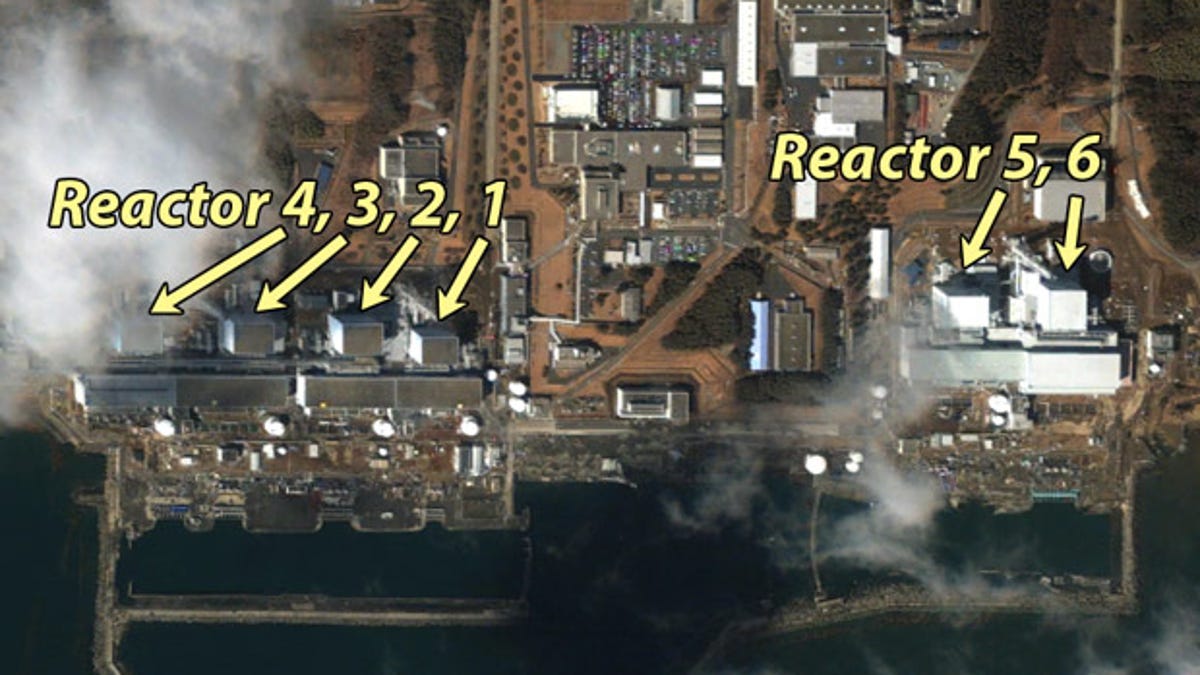Overheating, radiation troubles mount at Japan reactors
Fires, explosions, and venting gas is making it hard to keep the Fukushima Daiichi reactors' nuclear fuel cool, and many workers have been evacuated.

This illustration, based on GeoEye satellite photo viewed through Google Earth, shows the locations of the six Fukushima Daiichi nuclear reactors. The reactors are about 140 miles northeast of Tokyo.
Problems are cascading at a Japanese power plant, where explosions and fires are making it dangerous for workers to try to keep new overheating problems in check.
The Fukushima Daiichi plant on the northeast coast of Japan, with six reactors, was damaged by last week's magnitude 9.0 earthquake and resulting tsunamis. When the natural disaster struck, reactors 1, 2, and 3 were running and units 4, 5, and 6 were shut down for a regular inspection.
The first overt problems appeared at the three operating reactors, where heat remains an issue even though control rods were automatically inserted to stop the nuclear reaction when the quake struck. Now, though, troubles are spreading to the other reactors, leading to an unusual but aborted attempt to cool nuclear fuel by dumping water from a helicopter today.
And those troubles are spreading to the workers and potentially to others, because fires and hot-gas venting release radiation to the environment. Overheating can lead to a meltdown, in which the nuclear fuel gets so hot it melts, possibly breaching containment mechanisms.
Here's how the problem escalated, according to accounts from the Tokyo Electric Power Co. (Tepco), which runs the plant, and the International Atomic Energy Agency (IAEA), which oversees nuclear issues for the United Nations.
On Friday, the earthquake and tsunami knocked out the site's main electrical power supply and backup generators, making it hard to cool the nuclear fuel rods in the reactors and the cooling ponds nearby.
On Saturday, an explosion from a buildup of hydrogen gas damaged the building around reactor 1. The explosion didn't breach the containment vessel around the reactor itself within the building, however. On Monday, a second similar explosion occurred at reactor 3. To try to keep the reactors cool, the operators started pumping seawater into the reactors, a last-ditch measure.
On Tuesday, the water level in reactor 2 couldn't be kept up, and it too suffered an explosion even though workers had begun pumping seawater into it on Monday. This explosion, at 6:14 a.m. local time, was more serious: it damaged the reactor's primary containment vessel.
Bad went to worse at 8:54 a.m., when a two-hour fire began at reactor 4. "The spent fuel storage pond at the unit 4 reactor of the Fukushima Daiichi nuclear power plant is on fire and radioactivity is being released directly into the atmosphere," the IAEA said. The reactor's fuel had been unloaded during the inspection and stored in the fuel pond.
There had been much smaller releases of radiation from earlier events, for example when workers vented air to relieve pressure, but this fire was much more serious.
At one point on Tuesday, the radiation level was at a dose of 400 millisieverts per hour between reactors 3 and 4, the IAEA said. For comparison, the annual dose limit for workers in Japan is 50 millisieverts per year. An emergency level permitted 100 millisieverts per year, but that's been raised to 250 millisieverts per year, according to information from Japan's Ministry of Education, Culture, Sports, Science, and Technology. A chest X-ray has a dose of about 0.2 millisieverts, and the average person gets a dose of about 2.4 millisieverts per year from natural sources such as radon and cosmic rays, according to the IAEA.
By early this morning, radiation levels had dropped to a dose rate of 0.6 millisieverts per hour.
An evacuation of residents within 20 kilometers of the Fukushima Daiichi plant already had begun, and it was finished Tuesday. With the new events, the Japanese government also advised people living within 30 kilometers to stay indoors.
At the plant itself, most workers were evacuated. The New York Times shows the harrowing lives the remaining 50 employees lead trying to deal with the power plant's problems, though their plight eased somewhat when dropping radiation levels permitted 50 people to return.
Today, workers focused attention on reactor 3, which is fueled with a combination of plutonium and uranium oxides. The reactor was emitting steam, leading authorities to believe the containment vessel had ruptured.
To try to cool fuel at the spent-fuel pools at reactors 3 and 4, personnel in a military helicopter tried dropping water from a helicopter, according to media reports. That didn't work, apparently because of concerns about flying the helicopter in the radioactive steam. (Al Jazeera English has footage of the helicopter cooling attempt. See the video embedded below.) Another plan is to spray water from ground positions onto the hot spots.
Reactor 4 doesn't appear to be the only one that's got problems despite being shut down. The water level at reactor 5 also is dropping, down to a level 201cm above the top of the stored fuel rods by 9 p.m. local time Tuesday, the IAEA said. That was a 40cm drop from five hours earlier.
To deal with the situation, plant operators planned to use a diesel generator at reactor 6 to pump in new water. Reactors 5 and 6 were still loaded with fuel during the inspection.
The situation has undermined a renaissance of the nuclear energy industry. And with the world's eyes upon the nuclear plant's crisis, a new tone came to Tepco's ordinarily terse, bare-facts reports. In one report Wednesday, Tepco said:
"We are aware of and sincerely apologize for the great distress and inconvenience this incident has caused to not just those inhabitants residing in the immediate vicinity but also society at large."

